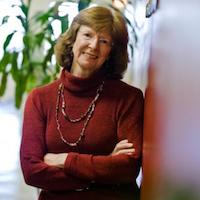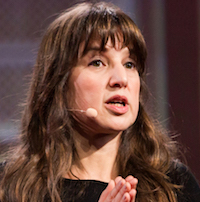 On March 12th-14th, the National Academies of Science held an Arthur M. Sackler Colloquia on Creativity and Collaboration: Revisiting Cybernetic Serendipity. The colloquia, organized by Ben Shneiderman (University of Maryland), Maneesh Agrawala (Stanford), Alyssa Goodman (Harvard), Youngmoo Kim (Drexel), and Roger Malina (UT Dallas), examined the historical framework of cybernetic serendipity –the concept of unplanned creation derived from cybernetic processes. The term is derived from an exhibition of cybernetic art curated by Jasia Reichardt that toured touring the United States in the late 1960s.
On March 12th-14th, the National Academies of Science held an Arthur M. Sackler Colloquia on Creativity and Collaboration: Revisiting Cybernetic Serendipity. The colloquia, organized by Ben Shneiderman (University of Maryland), Maneesh Agrawala (Stanford), Alyssa Goodman (Harvard), Youngmoo Kim (Drexel), and Roger Malina (UT Dallas), examined the historical framework of cybernetic serendipity –the concept of unplanned creation derived from cybernetic processes. The term is derived from an exhibition of cybernetic art curated by Jasia Reichardt that toured touring the United States in the late 1960s.
The colloquia attempted to answer:
- “How should we re-envision research policy and educational structures to maximize the impact of partnerships with design, art, and humanities?
- How can we productively engage business, government, and non-governmental organizations as research and educational partners?”
Of particular interest to the computing community were the citizen science focused-sessions of the program, which took place in the afternoon of the 14th. This session offered a look at a number of computing-focused citizen science projects, the challenges they face, and opportunities for computer science to enhance the space.
 Jennifer Preece, University of Maryland, discussed how the proliferation of cellphones and the Internet have enabled citizen science and led to a recent surge in citizen science projects and websites. Dr. Preece presented examples of citizen science projects to track and identify wildlife being done on websites like nature-net.org, ispotnature.org, ebird.org, and inaturalist.org. Each site offered different solutions to generate user interest and ensure quality data – for instance iSpotnature has a 5 star rating system for different categories (i.e. rating plants, birds, etc.) that provides a reputation based on the “validity” of posts, while iNaturalist uses a leaderboard to provide users incentives to post. However, each system comes with its own pros and cons. For instance, there has been research that suggest that women and minorities don’t get as involved in leaderboard activities, which could lead to less activity from those participants and therefore a less inclusive forum.
Jennifer Preece, University of Maryland, discussed how the proliferation of cellphones and the Internet have enabled citizen science and led to a recent surge in citizen science projects and websites. Dr. Preece presented examples of citizen science projects to track and identify wildlife being done on websites like nature-net.org, ispotnature.org, ebird.org, and inaturalist.org. Each site offered different solutions to generate user interest and ensure quality data – for instance iSpotnature has a 5 star rating system for different categories (i.e. rating plants, birds, etc.) that provides a reputation based on the “validity” of posts, while iNaturalist uses a leaderboard to provide users incentives to post. However, each system comes with its own pros and cons. For instance, there has been research that suggest that women and minorities don’t get as involved in leaderboard activities, which could lead to less activity from those participants and therefore a less inclusive forum.
 Laura Trouille, Director of Citizen Science at the Adler Planetarium and Co-I of Zooniverse focused on the history and future of the Zooniverse project. The Zooniverse currently has 80 active online citizen science projects with over 1.6 million registered volunteers covering topics that range from astronomy, ecology, biomedicine, and the humanities. About a quarter of Zooniverse projects are camera-tracking project, i.e. identifying animals detected and photographed by motion capture cameras. Through the crowds present in the Zooniverse, they were able to uncover images of the rare zorilla in the Serengeti – something that was only possible because of thousand of people viewing millions of photos. Citizen scientists were also part of discovering the WTF star, which had a highly unusual light curve that was noticed by citizen scientist D.M. LaCourse. Dr. Trouille also focused upon the need for human-machine integration for the future of citizen science. Using machine learning can lower the barrier to entry by presenting the data in a more manageable form to enable volunteers to quickly get into the exploration and analysis phase. Imagine if when someone finds a suspected exoplanet, rather than have to sort through everything themselves, they could view all the data and metadata available about that object. Getting those millions of data points into something easily digestible by humans is task for machine learning.
Laura Trouille, Director of Citizen Science at the Adler Planetarium and Co-I of Zooniverse focused on the history and future of the Zooniverse project. The Zooniverse currently has 80 active online citizen science projects with over 1.6 million registered volunteers covering topics that range from astronomy, ecology, biomedicine, and the humanities. About a quarter of Zooniverse projects are camera-tracking project, i.e. identifying animals detected and photographed by motion capture cameras. Through the crowds present in the Zooniverse, they were able to uncover images of the rare zorilla in the Serengeti – something that was only possible because of thousand of people viewing millions of photos. Citizen scientists were also part of discovering the WTF star, which had a highly unusual light curve that was noticed by citizen scientist D.M. LaCourse. Dr. Trouille also focused upon the need for human-machine integration for the future of citizen science. Using machine learning can lower the barrier to entry by presenting the data in a more manageable form to enable volunteers to quickly get into the exploration and analysis phase. Imagine if when someone finds a suspected exoplanet, rather than have to sort through everything themselves, they could view all the data and metadata available about that object. Getting those millions of data points into something easily digestible by humans is task for machine learning.
 Julia Parrish’s, University of Washington, presentation was on the COASST (Coastal Observation and Seabird Survey Team) project. Housed at the University of Washington, COASST trains the residents of coastal areas to conduct monthly surveys on beaches for research purposes. The participants mostly focus on beached birds, marine debris, or other evidence of human use of the beach. Thought collecting bird carcasses does not necessarily sound like a great Saturday morning, you can determine a lot of information about the diets and lifestyles of a bird by looking at their feet, something that is much more easily done once they are dead. Unfortunately, there are still beach-based limitations (sun, sand, salt, precipitation) and technology-based limitations (expense of phone, mobile coverage, screen size issues for older volunteers) that must be overcome – challenges that perhaps the computing community could address.
Julia Parrish’s, University of Washington, presentation was on the COASST (Coastal Observation and Seabird Survey Team) project. Housed at the University of Washington, COASST trains the residents of coastal areas to conduct monthly surveys on beaches for research purposes. The participants mostly focus on beached birds, marine debris, or other evidence of human use of the beach. Thought collecting bird carcasses does not necessarily sound like a great Saturday morning, you can determine a lot of information about the diets and lifestyles of a bird by looking at their feet, something that is much more easily done once they are dead. Unfortunately, there are still beach-based limitations (sun, sand, salt, precipitation) and technology-based limitations (expense of phone, mobile coverage, screen size issues for older volunteers) that must be overcome – challenges that perhaps the computing community could address.
 Niki Kittur, professor at the Human Computer Interaction Institute at Carnegie Mellon, highlighted the human ability to creatively accumulate and recombine knowledge and information in non-routing ways. One such example: a way of safely removing a baby from the birthing canal, which was invented by Jorge Odon, an Argentinian car mechanic who was inspired by a Youtube video on removing a cork from a bottle. In Dr. Kittur’s lab he has explored “how we can take this process of analogy out of a single person’s head and distribute it across many people.” For this he described an analogical process of taking an example, abstracting its purpose and/or mechanism, and transferring those principles to a new domain to generate new ideas. He has found three key challenges to scaling serendipitous analogy:
Niki Kittur, professor at the Human Computer Interaction Institute at Carnegie Mellon, highlighted the human ability to creatively accumulate and recombine knowledge and information in non-routing ways. One such example: a way of safely removing a baby from the birthing canal, which was invented by Jorge Odon, an Argentinian car mechanic who was inspired by a Youtube video on removing a cork from a bottle. In Dr. Kittur’s lab he has explored “how we can take this process of analogy out of a single person’s head and distribute it across many people.” For this he described an analogical process of taking an example, abstracting its purpose and/or mechanism, and transferring those principles to a new domain to generate new ideas. He has found three key challenges to scaling serendipitous analogy:
- The first is fixation – seeing an example that rather than inspiring you, leads to homogenous ideas. However, Dr. Kittur found that if a different set of people only see the purpose and mechanism schemas then you will see a significant increase in the quality of their ideas.
- The second challenge is expertise. In his work with R&D professionals he has seen two main approaches – in house R&D teams and crowd generated ideas, primarily through contests. In house R&D teams have experience and context but limitations in terms of time and fixation. Crowd generated ideas are often novel, but they lack the experience or context to produce workable ideas and contests are really inefficient – 99% of people don’t get rewarded and the work is discarded. What if these two ideas were combined to support each other? The crowd generates new ideas, but the R&D professional apply those ideas specifically with their greater knowledge.
- The third problem is scaling – with billions of problems and solutions even crowds won’t be enough, we need computational tools. This brings machine learning and AI into the picture. Dr. Kittur built a system that uses deep learning to search for objects with a similar purpose but differing mechanisms by turning these two concepts into searchable vectors. When groups of people were given these machine-generated analogies, they had a higher proportion of good ideas than either the surface or random groups. Dr. Kittur hypothesizes that an innovation network, like the power grid or highway system could transform the US economy.
 Writer and academic, Zeynep Tufekci, discussed the impact of social media on politics and social movements. Modern political movements, such as Arab Spring, have been supported and spread through social media. However, as the latest U.S. election has shown, nefarious actors can utilize the networking effects of social media to propagate divisive and anti-social ideas to hijack social media. For example, if you watch multiple videos of a Donald Trump rallies, Youtube is more likely to recommend videos related to white supremacy. Vice versa, if you watch Hillary Clinton or Bernie Sanders videos, Youtube will recommend left-wing conspiracies. A similar effect can be found across a variety of social media website because of the underlying algorithms running these systems. Tufekci did not accuse the technologies themselves of being maliciously run, but called for greater oversight of these services and their algorithms to combat these problems and utilize them for the greater good.
Writer and academic, Zeynep Tufekci, discussed the impact of social media on politics and social movements. Modern political movements, such as Arab Spring, have been supported and spread through social media. However, as the latest U.S. election has shown, nefarious actors can utilize the networking effects of social media to propagate divisive and anti-social ideas to hijack social media. For example, if you watch multiple videos of a Donald Trump rallies, Youtube is more likely to recommend videos related to white supremacy. Vice versa, if you watch Hillary Clinton or Bernie Sanders videos, Youtube will recommend left-wing conspiracies. A similar effect can be found across a variety of social media website because of the underlying algorithms running these systems. Tufekci did not accuse the technologies themselves of being maliciously run, but called for greater oversight of these services and their algorithms to combat these problems and utilize them for the greater good.
You can find videos from the symposium on YouTube and learn more about the symposium on their webpage.









